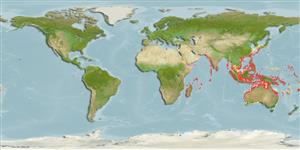Common names from other countries
>
Gobiiformes (Gobies) >
Gobiidae (Gobies) > Gobionellinae
Etymology: Oxyurichthys: Greek, oxys = sharpen + Greek, oura = tail + Greek, ichthys = fish (Ref. 45335).
More on author: Valenciennes.
Environment: milieu / climate zone / depth range / distribution range
Ecologia
marinhas; estuarina associadas(os) a recifes; intervalo de profundidade 1 - 50 m (Ref. 37816). Tropical
Indo-West Pacific: Red Sea south to Natal, South Africa and east to the tropical west Pacific.
Tamanho / Peso / Idade
Maturity: Lm ? range ? - ? cm
Max length : 22.0 cm TL macho/indeterminado; (Ref. 127374); peso máx. publicado: 52.00 g (Ref. 127374)
Descrição suscinta
Chaves de identificação | Morfologia | Morfometria
Espinhos dorsais (total) : 7; Raios dorsais (total) : 12; Espinhos anais: 1; Raios anais : 13. Body brown with 7-8 vertical dark brown bars (Ref. 2798); characterized further by pale brownish grey body color with orange spots/bands on cheek and operculum; united pelvic fins, well developed frenum present; long and pointed caudal fin, nearly twice length of head; longitudinal scale series 75-80; ctenoid scales posteriorly to below middle of first dorsal fin, becoming cycloid anteriorly; scales absent on head, midline of nape and prepectoral area; low fleshy ridge on midline of nape; depth of body 5.6-6.5 in SL (Ref. 90102).
Occurs inshore (Ref. 4343), mud bottoms of estuaries and protected bays (Ref. 37816). Found on open flat bottom and large adults mostly seen at about 30 meters depth. Dives head first into the mud for safety (Ref. 48637). Hides in a burrow, but can dive into mud to escape predators (Ref. 11441).
Ciclo de vida ou comportamento de acasalamento
Maturities | Reprodução | Spawnings | Egg(s) | Fecundities | Larvas
Maugé, L.A., 1986. Gobiidae. p. 358-388. In J. Daget, J.-P. Gosse and D.F.E. Thys van den Audenaerde (eds.) Check-list of the freshwater fishes of Africa (CLOFFA). ISNB, Brussels; MRAC, Tervuren; and ORSTOM, Paris. Vol. 2. (Ref. 4343)
Status na Lista Vermelha da UICN (Ref. 130435)
CITES (Ref. 128078)
Not Evaluated
Ameaça para os humanos
Harmless
Uso pelos humanos
Pescarias: espécies comerciais; Aquário: Espécies comerciais
Ferramentas
Relatórios especiais
Baixar XML
Fontes da internet
Estimates based on models
Preferred temperature (Ref.
115969): 24.6 - 29, mean 27.9 (based on 950 cells).
Índice de diversidade filogenética (Ref.
82804): PD
50 = 0.5000 [Uniqueness, from 0.5 = low to 2.0 = high].
Bayesian length-weight: a=0.00912 (0.00568 - 0.01465), b=2.94 (2.81 - 3.07), in cm Total Length, based on LWR estimates for this species & (Sub)family-body (Ref.
93245).
Nível Trófico (Ref.
69278): 3.5 ±0.37 se; based on food items.
Resiliência (Ref.
120179): médio(a), tempo mínimo de duplicação da população 1,4 - 4,4 anos (Preliminary K or Fecundity.).
Fishing Vulnerability (Ref.
59153): Low vulnerability (12 of 100).
